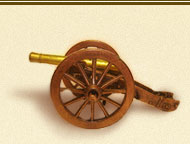The tradition of soldiers making goes back centuries. Up till now the archaeologists find warriors figures, talismans of medieval pilgrims, depicting saints and their deeds. First materials were wood, bronze and clay. One of the earliest lead soldiers is in the British National Museum, and it was dated to the 250 AD. In the XIV century in Seine river the half volumetric lead figure of a knight (60 mm) was founded. It is exhibited now in Musée de Cluny in Paris.
It is interesting to look back and see how the miniature history changed for several centuries. The largest centers of tin soldiers production were German cities. In 1578 the Nuremberg city council legalized the creation of figures as children's toys. They were in demand by various classes and soon became widespread throughout Europe. In 1610, French King Louis XIII got 300 silver toy soldiers as a present made by German jeweller Roger. Louis XIV, “Sun King”, ordered in Nuremberg the figurines of silver and gold warriors from the drawings of famous fortification engineer Vauban. During the reign of Russian Empress Anna Ioannovna the Nuremberg Shop of Dozer appeared on Nevsky prospect that sold all kind of toys with tricky mechanisms. It is known that the Emperor Peter III was the owner of soldiers collection from Germany. They were volumetric and intended for military tactics training.
The heyday of the flat tin miniatures is related to Johannes Hilpert (born in Coburg, Saxony). In 1760 he founded a separate proceeding and in a short time developed tin figurines benchmark, turning the simple toy into the artwork. The high merchantability required from the masters the search of efficient ways for toy soldiers producing. At this point an artist and engraver E.Heinrichsen from Shlezin appeared in the history of tin miniature. In 1839 he opened his production in Nuremberg and introduced 30mm size figures. His products became extremely popular and subsequently gained international recognition named "Nuremberg miniatures". In the second half of the XIX century the examples of military and historical miniatures were made primarily by orders of Europe kings. The details of arms and uniforms of different army eras were reproduced in figurines with scrupulous accuracy. By the end of XIX century Nuremberg companies produced up to 500 figures per day. German engravers liked to depict Russian monarchs. For example, at the beginning of XX century they made the miniature “Empress Alexandra Fyodorovna wearing the uniform dress of Life Guards Her Majesty Lancers Regiment” and “Princess the Great Olga Nikolaevna wearing the uniform dress of Elisavetgradskiy Hussars Regiment”.
As of today there are three main types of tin soldiers: volumetric image (“small plastic arts”), flat and half-volumetric figures. But there are many ways of tin miniature producing. One of them you will know in “Manufacturing of Tin Soldiers” section.






